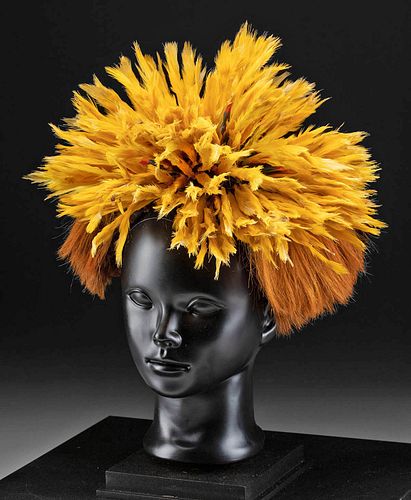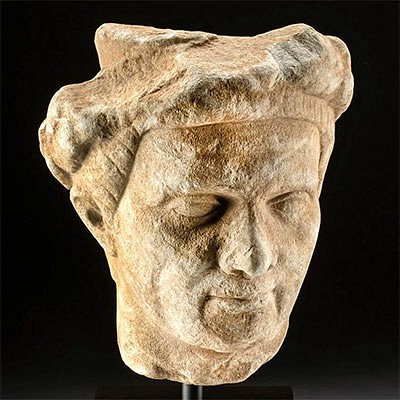Rare Nazca Royalty Feather & Hair Headdress Crown
Lot 126
About Seller
Artemis Fine Arts
686 S Taylor Ave, Ste 106
Louisville, CO 80027
United States
Selling antiquities, ancient and ethnographic art online since 1993, Artemis Gallery specializes in Classical Antiquities (Egyptian, Greek, Roman, Near Eastern), Asian, Pre-Columbian, African / Tribal / Oceanographic art. Our extensive inventory includes pottery, stone, metal, wood, glass and textil...Read more
Estimate:
$8,000 - $12,000
Absentee vs Live bid
Two ways to bid:
- Leave a max absentee bid and the platform will bid on your behalf up to your maximum bid during the live auction.
- Bid live during the auction and your bids will be submitted real-time to the auctioneer.
Bid Increments
| Price | Bid Increment |
|---|---|
| $0 | $25 |
| $300 | $50 |
| $1,000 | $100 |
| $2,000 | $250 |
| $5,000 | $500 |
| $10,000 | $1,000 |
| $20,000 | $2,500 |
| $50,000 | $5,000 |
| $100,000 | $10,000 |
| $200,000 | $20,000 |
About Auction
By Artemis Fine Arts
Jun 1, 2023
Set Reminder
2023-06-01 10:00:00
2023-06-01 10:00:00
America/New_York
Bidsquare
Bidsquare : Ancient | Asian | Ethno | Native American Art
https://www.bidsquare.com/auctions/artemis-gallery/ancient-asian-ethno-native-american-art-12905
Featuring classical antiquities, ancient, and ethnographic art from cultures encompassing the globe. Egyptian, Greek, Roman, Near Eastern, Asian, Pre-Columbian, Native American, African / Tribal, Oceanic, Spanish Colonial, Fossils, more! All legally acquired, legal to sell. Satisfaction guaranteed. Artemis Fine Arts info@artemisfinearts.com
Featuring classical antiquities, ancient, and ethnographic art from cultures encompassing the globe. Egyptian, Greek, Roman, Near Eastern, Asian, Pre-Columbian, Native American, African / Tribal, Oceanic, Spanish Colonial, Fossils, more! All legally acquired, legal to sell. Satisfaction guaranteed. Artemis Fine Arts info@artemisfinearts.com
- Lot Description
Pre-Columbian, South Coast Peru, Nazca, ca. 300 to 500 CE. An incredible feather and hair headdress with brilliant feathers and human hair, attached to the feathers via knotted interlacing cords, the hair set to the sides and left naturally black and dyed an orange color. The paradise tanager (Tangara chilensis) and blue-and-yellow macaw (Ara ararauna) may have supplied the feathers for the crest. Colorful feathers were prized materials in Andean cultures and used by the elite for clothing and ornaments. Avian motifs and the use of feathers were symbolic in Andean cultures, for birds were sacred animals that could fly between worlds and were messengers for the gods. All is displayed in a museum quality acrylic case that demonstrates how this was worn. Wig headdresses have been found in association with mummy bundles of elite people and royalty, the feather and fibers preserved by the arid climate and burial practices. A spectacular and truly rare piece! Size: 10" Diameter x 9" H (25.4 cm x 22.9 cm); case: 15" L x 13" W x 25.5" H (38.1 cm x 33 cm x 64.8 cm)
The ancients of the Andes held parrots in high esteem, thought to be incarnations of sky deities for their ability to fly well above the tree line, but also prized for their brilliant plumage. According to scholar Christine Dixon, "The brilliant feathers of South American birds, especially from parrots such as the Scarlet Macaw, were desired by most ancient Peruvian cultures. Their use for costumes and decorations, sometimes far from the birds' habitats, points to the trade and exchange of feathers between the lowlands and forests and the highlands and coasts of Peru. According to detailed studies of the types of birds used, the objects were typically made from the feathers of birds found in the tropical zones at lower altitudes [of the Andes] in eastern Peru and the Amazon Basin. Of the 1800 native species, most were chosen for their colorful plumage or avian characteristics: the eagle was associated with power and strength, for instance. Birds frequented the sky and therefore represented the upper world or the heavens. Yellow plumage may have been so coveted because it stood for the sun, light, gold and the gods." (Source: Christine Dixon, "Lost Worlds of Peru: Nazca Culture," National Gallery of Australia)
Provenance: private Hawaii collection, acquired 2000 to 2010
All items legal to buy/sell under U.S. Statute covering cultural patrimony Code 2600, CHAPTER 14, and are guaranteed to be as described or your money back.
A Certificate of Authenticity will accompany all winning bids.
We ship worldwide and handle all shipping in-house for your convenience.
#177483Some fading and discoloration and bending to feathers. Overall excellent. Some active flaking to feathers, so we recommend handling as little as possible. Modern ribbon tied under the feathers. Displayed in custom museum quality acrylic case.Condition
- Shipping Info
-
All shipping is handled in-house for your convenience. Your invoice from Artemis Gallery will include shipping calculation instructions. If in doubt, please inquire BEFORE bidding for estimated shipping costs for individual items.
-
- Buyer's Premium



 EUR
EUR CAD
CAD AUD
AUD GBP
GBP MXN
MXN HKD
HKD CNY
CNY MYR
MYR SEK
SEK SGD
SGD CHF
CHF THB
THB














